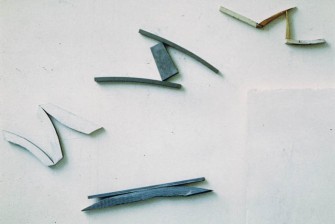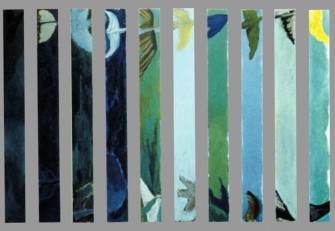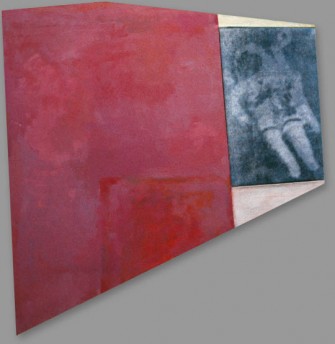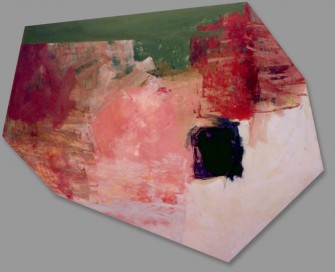from: “Zeitgenössische Kunst in der Deutschen Bank” (Contemporary Art in the Deutsche Bank), catalogue of the Deutsche Bank Collection, Frankfurt/Main
Bernd Fischer attended the Hochschule für Gestaltung (School of Design) from 1974 until 1980 under Hans Peter Münch and the Städel School in Frankfurt/Main from 1976 until 1982 under Michael Croissant. He considers his student years “in hindsight, as a time of trying out different approaches, intensively getting to know the medium and myself”.
 Four Single Objects Without Title
Four Single Objects Without Title
1978
Color on Wood
Each approx. max. 30 x 50 cm
Photograph: Hanging in atelier, Städel School
Object left: Christian Friedrichs;
Object upper center: Later Innovation Award
For a while he experimented with objects made of waste timber, a path which soon “appeared as a dead-end-street”. This is why he took up painting again, because he believed that with it he would be able to realize his idea of figure. In spite of this, Fischer’s paintings are reminiscent of the period with objects because he rejects conventionally-shaped picture carriers such as regular squares, for example. The works on nettle, canvas and wood are of asymmetric shape or consist of several parts. Figure or object is also always placed in relation to the pure area of color. In so doing Fischer suggests that today the theme of figure needs to be rethought and reformulated.
The development in the shape of the picture carrier ranges from plates joined directly with one another to extreme horizontal or vertical formats, serial sequences of single panels, narrow slats concentrated into areas of color all the way to asymmetrically rearranged rhombi from which ar-eas are sawn out to accommodate smaller partial areas. For Fischer turning to painting means an experiment not just with color but especially with form. The fact that form in particular has an important effect can be seen in the exemplary comparison of two works. In a picture which con-sists of ten narrow, upright rectangles Fischer deals with one of his favorite subjects, flying in undefined space. Here the form which divides the color continuity is joined together again by the image content (flight of birds).
 Bird Flight With Mirror image
Bird Flight With Mirror image
1983
Tempera / oil nettle, ten parts
170 x 300 cm
By contrast, where the picture space consists of narrow slats a color continuity appears even without reference to content, because here color alone seems to push the image to the right. Just how important form is for Fischer’s work can be seen from the fact that the impression of instability is achieved mainly through shapes which deviate from symmetrical geometry. Longer and shorter, wider and narrower panels are joined together at such sharp angles that they result in narrow gaps which lend an overall impression of fragility to the works. In addition, the affinity of the individual parts can be deciphered through the painting rather than through the form, this is for instance the case when the rectangular shape of the small panel is repeated on the accompanying larger panel. In Fischer’s works, in other words, form can be changed and color is merely placed in relation to it. In a reversal of traditional panel painting the more stabile moment is not form but color. Expressed in this exchangeability of the relation-ship of parts of shapes to one another is a current awareness of irreversibility and instability.
 Astronaut
Astronaut
1985
painted and printed color on canvas and calico
two parts, 125 x 135 cm
Evonic Services GmbH
(was befor Degussa Hüls AG)
Fischer’s preferred subjects are bird, hand and astronaut. Flying – as natural as it is to a bird, makes man dependent on technology. What first appeared as a liberation shackles him. Shrouded as if in a cocoon he is forced to submit to artificial conditions which turns him into the human-machine astronaut. The very physical and psychological conditions which constitute man are encapsulated. In this context the hand as carrier of direct movements, of tactile sense and immediate human warmth acquires the character of a symbol for the longing for manual balance in a world of ‘de-manualized technicity’. Since technology results in the abandoning of the direct movements translated by the hand, its central depiction is a symbol for the grief over the loss of individual potential.
 Head
Head
1986
Tempera on wood, two parts
113 x 144 cm
Deutsche Bank, Frankfurt/Main